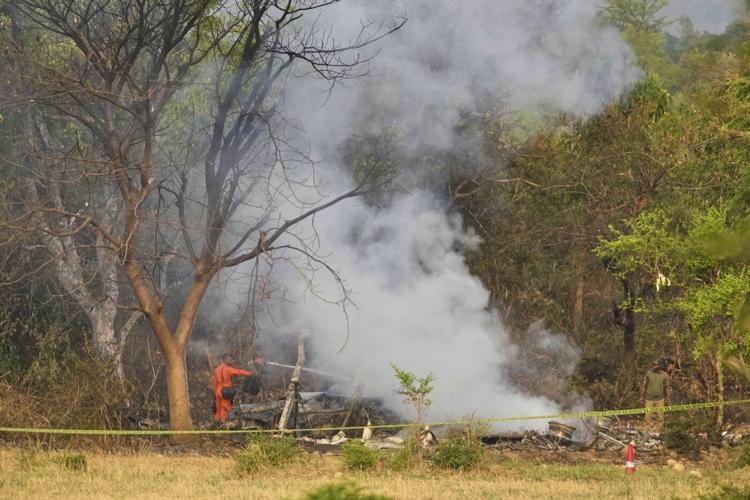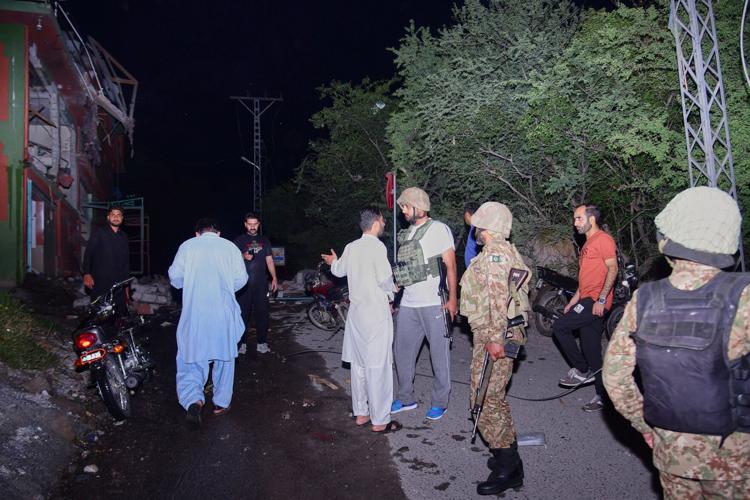ISLAMABAD (AP) ŌĆö India fired missiles at Pakistan early Wednesday, in what it said was retaliation for last monthŌĆÖs massacre of Indian tourists. Pakistan called the strikes an act of war and claimed it downed several Indian fighter jets.
The at least nine sites ŌĆ£where terrorist attacks against India have been planned,ŌĆØ IndiaŌĆÖs Defense Ministry said. PakistanŌĆÖs military said the missiles hit six locations in Pakistan-administered Kashmir and in the countryŌĆÖs Punjab province and killed more than two dozen people, including children.
Pakistan said it reserved the right to respond, raising the specter that the back-and-forth could spiral into all-out conflict. Already, itŌĆÖs the worst confrontation between the rivals since 2019, when they came close to war.
Following the strikes, there was a heavy exchange of fire that officials in each country said left more people dead. Three planes in India-controlled territory, according to Indian police and residents, though it was not immediately clear if they were downed by Pakistan.
Tensions have soared between the nuclear-armed neighbors since , mostly Indian Hindu tourists, in India-controlled Kashmir, in some cases killing men before their wivesŌĆÖ eyes.
India accuses Pakistan of being behind the attack, which was claimed by a militant group calling itself Kashmir Resistance. India has said the group is linked to Lashkar-e-Taiba, a disbanded Pakistani militant group.
Islamabad denies involvement.
India and Pakistan have fought over the , which is split between them and claimed by both in its entirety.
In the wake of the massacre, , closed their borders and shuttered airspace. India has also suspended a critical water-sharing treaty with Pakistan.
The escalation raises the risk of war
Pakistani condemned the airstrikes and said his country would retaliate.
ŌĆ£Pakistan has every right to give a robust response to this act of war imposed by India, and a strong response is indeed being given,ŌĆØ Sharif said.
It was not clear if PakistanŌĆÖs claim that it shot down fighter jets constituted its retaliation or if more might be coming.
The country’s National Security Committee said Pakistan reserves the right to respond ŌĆ£in self-defense, at a time, place, and manner of its choosing.ŌĆØ
The statement said the strikes were carried out ŌĆ£on the false pretext of the presence of imaginary terrorist campsŌĆØ and said they killed civilians.
South Asia analyst Michael Kugelman said the strikes were some of the highest-intensity ones from India on its rival in years and that PakistanŌĆÖs response would ŌĆ£surely pack a punch as well.ŌĆØ
ŌĆ£These are two strong militaries that, even with nuclear weapons as a deterrent, are not afraid to deploy sizeable levels of conventional military force against each other,ŌĆØ Kugelman said. ŌĆ£The escalation risks are real. And they could well increase, and quickly.ŌĆØ
In 2019, the two countries came close to a war after a Kashmiri insurgent carrying Indian soldiers, killing 40. India carried out airstrikes in Pakistani territory, and Pakistan shot down an Indian warplane and captured the pilot, later releasing him.
U.N. Secretary-General Antonio Guterres called for maximum restraint because the world could not ŌĆ£afford a military confrontationŌĆØ between India and Pakistan, according to a statement from spokesperson Stephane Dujarric.
China also called for calm. Beijing is the largest investor in Pakistan by far and has multiple border disputes with India, including one in the northeastern part of the Kashmir region.
PakistanŌĆÖs National Security Committee met Wednesday morning. Indian Prime Minister Narendra Modi held a special meeting of the Cabinet Committee on Security and postponed his upcoming trip to Norway, Croatia and the Netherlands.
Several Indian states held civil defense drills Wednesday to train civilians and security personnel to respond in case of attack.
Scenes of panic and destruction
The missile strikes hit six locations and killed at least 26 people, including women and children, said PakistanŌĆÖs military spokesperson, Lt. Gen. Ahmed Sharif.
Officials said another 38 people were injured in the strikes, and five more people were killed in Pakistan during exchanges of fire across the border later in the day.
In Muzaffarabad, the main city of Pakistan-controlled Kashmir, resident Abdul Sammad said he heard several explosions as blasts ripped through houses. He saw people running in panic and authorities immediately cut power to the area.
People ran into the streets or open areas. ŌĆ£We were afraid the next missile might hit our house,ŌĆØ said Mohammad Ashraf, another resident.
Indian jets damaged infrastructure at a dam in Pakistan-administered Kashmir, according to Sharif, the military spokesman, calling it a violation of international norms.
The strikes also hit close to at least two sites previously tied to militant groups that have since been banned, according to Pakistan.
One hit Subhan Mosque in PunjabŌĆÖs Bahawalpur city, killing 13 people, according to Zohaib Ahmed, a doctor at a nearby hospital.
The mosque is near a seminary that was once the central office of Jaish-e-Mohammed, a militant group outlawed in 2002. Officials say the group has had no operational presence at the site since the ban.
Another missile hit a mosque in Muridke in Punjab, damaging it. A sprawling building located nearby served as the headquarters of Lashkar-e-Taiba until 2013, when Pakistan banned the militant group and arrested its founder.
IndiaŌĆÖs Defense Ministry called the strikes ŌĆ£focused, measured and non-escalatory in nature.”
“No Pakistan military facilities have been targeted,ŌĆØ the statement said, adding that ŌĆ£India has demonstrated considerable restraint.”
Indian politicians from different political parties lauded the operation, which was named ŌĆ£Sindoor,ŌĆØ a Hindi word for the vermillion powder worn by married Hindu women on their foreheads and hair. It was a reference to the women whose husbands were killed in front of them in the Kashmir attack.
Exchanges of fire and planes fall on villages in India-controlled Kashmir
Along the Line of Control, which divides the disputed region of Kashmir between India and Pakistan, there were heavy exchanges of fire.
Indian police and medics said 12 civilians were killed and at least 40 wounded by Pakistani shelling in Poonch district near the highly militarized de facto border. At least 10 civilians were also injured in KashmirŌĆÖs Uri sector, police said.
Shortly after IndiaŌĆÖs strikes, aircraft fell in three villages: two in India-controlled Kashmir, a third in India’s northern Punjab state.
Sharif, the Pakistani military spokesperson, said the countryŌĆÖs air force shot down five Indian jets in retaliation for the strikes. There was no immediate comment from India about PakistanŌĆÖs claim.
Debris from one plane was scattered across one village, including in a school and a mosque compound, according to police and residents. Firefighters struggled for hours to douse the resulting blazes.
ŌĆ£There was a huge fire in the sky. Then we heard several blasts also,ŌĆØ said Mohammed Yousuf Dar, a resident of Wuyan village in India-controlled Kashmir.
Another aircraft fell in an open field in Bhardha Kalan village. Resident Sachin Kumar told The Associated Press he heard massive blasts and saw a huge ball of fire.
Kumar said he and several others rushed to the scene, where they saw Indian soldiers carry away the pilots.
A third aircraft crashed in a farm field in Punjab, a police officer told the AP, speaking on the condition of anonymity because they were not authorized to speak to the media.
___
This story has been updated to correct that all three planes did not fall in India-controlled Kashmir. Two fell in India-controlled Kashmir, while a third fell in India’s Punjab state.
___
Saaliq and Roy reported from New Delhi, and Hussain reported from Srinagar, India. Associated Press writers Ishfaq Hussian in Muzaffarabad, Pakistan; Babar Dogar in Lahore, Pakistan; Asim Tanveer in Multan, Pakistan; and Huizhong Wu in Bangkok contributed to this story.





































